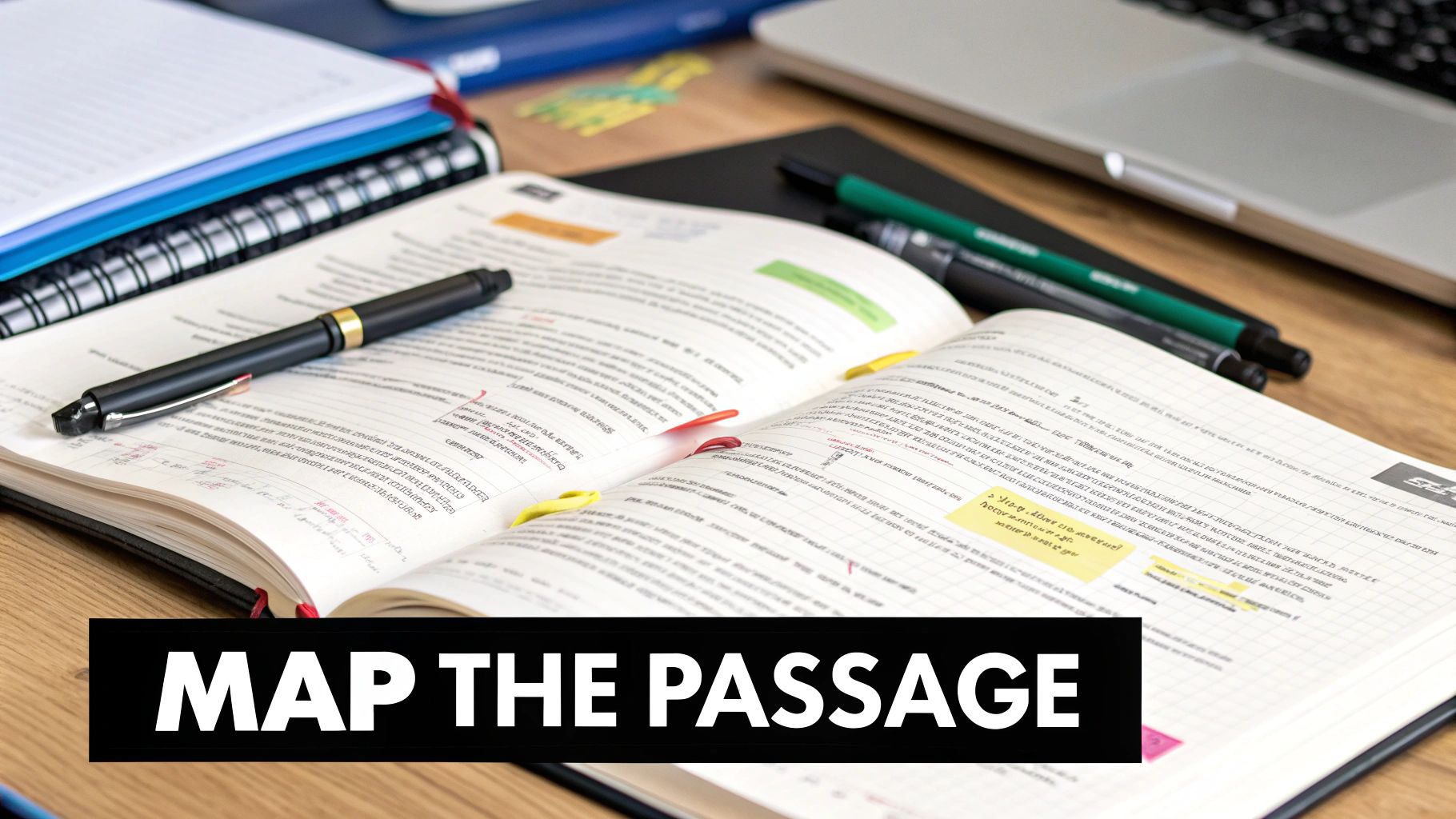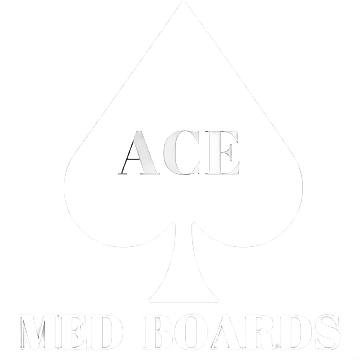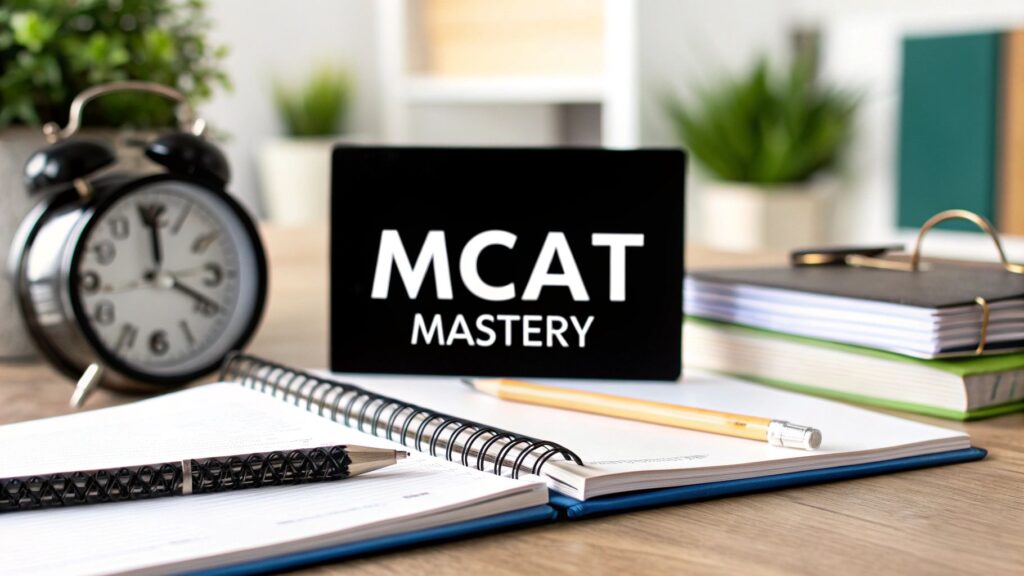The MCAT is more than a test of knowledge; it's a marathon of critical thinking, endurance, and strategy. While content mastery is the foundation, achieving an elite score requires a sophisticated approach to the exam itself. Many brilliant students fall short not because of what they don't know, but because of how they handle the pressure and structure of the test.
This guide moves beyond simple memorization to equip you with powerful, actionable MCAT test taking strategies. We will break down seven proven methods, from dissecting passages with passage mapping to managing every second with strategic timing, that transform how you approach the exam. Before diving into these techniques, ensure you have optimized your testing environment. This includes exploring testing accommodations like extended time on standardized tests if they apply to your situation, as having the right conditions is a critical first step.
These aren't just tips; they are comprehensive systems designed to build confidence, improve accuracy, and maximize your scoring potential. By integrating these strategies into your preparation, you'll learn to think like a top-scorer and turn a daunting challenge into a manageable, strategic endeavor.
1. Mastering the Art of Elimination: The POE Technique
Among the most effective MCAT test taking strategies is the Process of Elimination (POE). Instead of getting overwhelmed trying to pinpoint the single correct answer from four options, POE reframes your task. Your primary goal becomes identifying and confidently discarding the three incorrect choices. This strategic shift is crucial because the MCAT is infamous for its "distractor" answers, which are cleverly designed to seem plausible but contain a fatal flaw.

By actively hunting for these flaws, you transform each question into a critical thinking exercise, not just a test of memory. This method turns a blind 25% guess into a calculated 50% chance or even a 100% certainty. It’s a powerful tool across all sections, especially in the dense science passages and the nuanced CARS section.
How to Implement POE Effectively
The core of POE is to find concrete reasons to invalidate an answer choice. This requires a systematic approach, not just a gut feeling.
For Science Sections (C/P, B/B, P/S): Scrutinize each option for factual errors. In a biochemistry question about glycolysis, you might eliminate an answer mentioning an enzyme from the Krebs cycle. In a physics problem, immediately discard answers with incorrect units (e.g., Joules for power instead of Watts).
For the CARS Section: This is where POE shines. Compare each answer choice directly against the passage text. Eliminate options that are too extreme, use words like "always" or "never" when the author was more moderate, or introduce information outside the scope of the passage. You can also rule out choices that directly contradict the author's main argument.
Key Insight: POE is not just guessing. It is a logical deduction process. The strength of this MCAT test taking strategy lies in its ability to build confidence and accuracy by focusing on what you know is wrong, thereby revealing what must be right.
Actionable Tips for Test Day
To integrate POE into your workflow, practice these habits until they become second nature:
- Look for Absolutes: Words like all, none, always, never, and only are often red flags. MCAT passages and correct answers tend to be more nuanced.
- Physically Eliminate: On your scratch paper, write down A, B, C, D for the question number and physically cross out the letters as you eliminate them. This creates a clear visual record and prevents you from reconsidering a flawed choice.
- Find the Flaw: Don’t eliminate an answer unless you can articulate why it's wrong. Is it factually incorrect? Does it contradict the passage? Is it irrelevant?
- Start with the Obvious: Knock out the easiest-to-spot incorrect answers first. This builds momentum and simplifies the decision between the remaining, more plausible options.
2. Passage Mapping
MCAT passages, especially in the science sections, are dense with information, experimental details, and complex arguments. An incredibly effective MCAT test taking strategy to tackle this is Passage Mapping. This technique involves creating a brief, organized summary or "map" on your scratch paper as you read. Instead of trying to memorize every detail, you focus on identifying the passage's structure, main ideas, and key relationships, creating a quick-reference guide for the questions that follow.

This method prevents you from having to reread large chunks of text to find a specific piece of information, saving valuable time and reducing cognitive load. By mapping the flow of logic, you can quickly locate the hypothesis, experimental setup, results, and conclusions, allowing you to answer questions more efficiently and accurately.
How to Implement Passage Mapping Effectively
The goal of a passage map is speed and utility, not detailed note-taking. Your map should be a skeletal outline that captures the essence of each paragraph.
For Science Sections (C/P, B/B, P/S): Your map should focus on the scientific method. Jot down the Hypothesis/Goal, the Methods/Variables (what was changed, what was measured), the key Results (e.g., "Drug X ↑ Protein Y"), and the main Conclusion. For a biochemistry passage, you might track a specific molecular pathway and its regulatory steps.
For the CARS Section: The focus shifts from data to argumentation. For each paragraph, note the main point or function. Is the author introducing a topic, presenting evidence, refuting a counter-argument, or summarizing their stance? Note the author's tone (critical, neutral, supportive) and their overall main argument.
Key Insight: Passage mapping is not about rewriting the passage; it's about creating a functional directory. This MCAT test taking strategy transforms you from a passive reader into an active analyst, forcing you to engage with the text's structure and purpose from the very first read.
Actionable Tips for Test Day
To make passage mapping a seamless part of your test day routine, practice these techniques consistently.
- Use Abbreviations and Symbols: Develop a personal shorthand. Use arrows (↑ for increase, ↓ for decrease), acronyms, and symbols to save time. For example, "P1: Intro theory" or "P3: Exp1 – IV/DV".
- Focus on Paragraph Purpose: For each paragraph, ask yourself, "Why did the author include this?" and summarize its role in one to five words (e.g., Background, Method, Result 1, Counterpoint).
- Don't Get Bogged Down: The map is a tool, not the final product. Avoid capturing minor details or specific data points unless they are central to the main conclusion.
- Practice on Timed Sections: Integrate mapping into your timed practice tests. This will help you refine your technique, increase your speed, and prove its value under pressure.
3. Deconstructing the Prompt: The Power of Question Stem Analysis
One of the most powerful MCAT test taking strategies is mastering the art of Question Stem Analysis. Before your eyes even glance at the answer choices, your first task is to deeply understand what the question is asking. This methodical approach involves dissecting the prompt itself to identify keywords, constraints, and the specific task required, which prevents you from falling for distractor answers designed to punish a superficial reading.

This strategy forces you to slow down for a moment to speed up your overall progress and improve accuracy. By pinpointing the core question, you can retrieve information from the passage more efficiently and ignore irrelevant details. It’s a foundational skill, heavily emphasized in materials from the AAMC and top-tier prep companies like Altius and Blueprint, because it directly combats the MCAT's complexity.
How to Implement Question Stem Analysis Effectively
This process is about creating a mental roadmap before you start looking for the destination. It turns a reactive process into a proactive one, giving you control.
Identify the Question Type: Is it a pseudo-discrete question that requires simple recall? Is it asking for reasoning based on the passage? Or does it require you to bring in outside knowledge and apply it to a new scenario presented in the text? Recognizing this dictates where you'll find the answer.
Spot Key Modifiers: The MCAT loves to use specific phrasing. Look for words like "EXCEPT," "LEAST," or "NOT," which completely invert the question. A question asking which statement is least supported by the data requires you to find three true statements and one false one. Missing that single word leads to an almost guaranteed incorrect answer.
Key Insight: Analyzing the question stem is not just about reading the words; it's about defining your mission. This critical MCAT test taking strategy ensures you are answering the question the test-makers actually wrote, not the one you assumed they wrote.
Actionable Tips for Test Day
Practice these steps on every question until they become an automatic part of your routine:
- Highlight Directive Words: On your scratch paper or mentally, circle the action words. Are you asked to infer, identify, conclude, or provide evidence? Each word demands a different level of analysis.
- Note Qualifiers and Constraints: Pay close attention to phrases like "according to the passage," "based on Figure 1," or "in a non-enzymatic reaction." These phrases set the boundaries for your answer.
- Predict the Answer's Form: Before looking at options A, B, C, and D, try to predict what the correct answer should look like. For a physics calculation, you might predict the units. For a CARS question, you might predict the author's general sentiment.
- Rephrase the Question: If a prompt is confusing or convoluted, quickly rephrase it in your own words. Ask yourself, "What are they really asking me to find here?"
4. Strategic Time Management
The MCAT is a marathon, not a sprint, making time management one of the most critical MCAT test taking strategies you can master. Each section has a strict time limit, and your ability to pace yourself effectively can be the difference between a good score and a great one. The goal isn't to rush through questions but to allocate your limited time efficiently, ensuring you have a chance to answer every question without getting bogged down on any single problem.

This strategy involves moving beyond simply watching the clock. It requires developing an internal sense of pacing for different question types, from dense science passages to discrete recall questions. By practicing under timed conditions, you learn to make split-second decisions on whether to tackle a question, flag it for review, or make an educated guess and move on, maximizing your scoring potential across the entire exam.
How to Implement Strategic Time Management
Developing effective pacing requires a section-specific plan. The timing demands of the CARS section are vastly different from the science sections, so you must create and practice distinct benchmarks.
For C/P, B/B, and P/S Sections: A common approach is to budget approximately 1.5 minutes per question as a baseline. This means a 6-question passage should take about 9 minutes. Discrete questions should be faster, ideally around 90 seconds each, freeing up valuable time for more complex passage-based problems.
For the CARS Section: This section is all about passage management. Aim to spend between 8 to 10 minutes per passage, which includes reading the text and answering all associated questions. Sticking to this rigid schedule prevents you from losing excessive time on one difficult passage at the expense of others.
Key Insight: Effective time management is a proactive skill, not a reactive panic. By establishing and practicing with personal time goals, you control the exam's pace instead of letting the clock control you. This builds confidence and reduces test-day anxiety.
Actionable Tips for Test Day
Turn time management into an automatic reflex with these targeted practice habits. For more in-depth advice on this skill, which is crucial for medical students, learn more about Strategic Time Management on acemedboards.com.
- Practice with Official Timing: Always use the official AAMC time constraints during your full-length practice exams. This is the only way to accurately simulate the pressure of test day.
- Develop Personal Benchmarks: Are you faster at physics than organic chemistry? Adjust your internal clock accordingly. Know your strengths and weaknesses to allocate time wisely.
- Learn to Triage and Move On: If a question stumps you for more than two minutes, it's time to flag it and move on. It is far better to answer three easier questions correctly than to waste five minutes on one difficult problem.
- Do Regular "Time Checks": At the halfway point of each section, check the clock and the question number. This quick check helps you know if you need to speed up or if you are on a good pace.
5. Content Integration and Cross-Referencing
The MCAT is not just a test of isolated facts; it's an examination of your ability to think like a future physician by connecting information across disciplines. Content Integration and Cross-Referencing is a powerful MCAT test taking strategy that involves actively linking concepts from physics, chemistry, biology, and psychology. By recognizing these overlaps, you can solve complex, multi-step problems that are becoming increasingly common on the exam.
This approach mirrors the AAMC's own design philosophy, which emphasizes the foundational, interdisciplinary nature of modern medicine. Instead of studying organic chemistry in a vacuum, for example, you learn to see its reactions as the fundamental steps within the metabolic pathways you study in biochemistry. This transforms your understanding from a list of memorized facts into a cohesive web of knowledge.
How to Implement Content Integration Effectively
True integration requires you to move beyond subject-specific silos during your preparation. The goal is to see the underlying principles that unite different fields.
Biochemistry and Physics: When studying cellular metabolism, don't just memorize ATP yield. Apply physics principles of thermodynamics and electrostatics to understand why ATP hydrolysis is so exergonic or how the electron transport chain harnesses potential energy.
Biology and Psychology: Connect the biological basis of neurotransmitters and hormones (B/B section) to their impact on behavior, stress, and mental disorders (P/S section). For example, link the function of the sympathetic nervous system to the fight-or-flight response discussed in psychology.
Organic Chemistry and Biology: View metabolic pathways like glycolysis or the Krebs cycle as a series of organic chemistry reactions. Recognizing reaction types like nucleophilic acyl substitution or redox reactions in a biological context deepens your understanding and makes the information stick.
Key Insight: The MCAT rewards a holistic understanding. This MCAT test taking strategy is less about learning more content and more about building connections between the content you already know. This creates a more robust and flexible knowledge base that is less prone to forgetting under pressure.
Actionable Tips for Test Day
To develop an integrated mindset, you must practice it consistently. Here’s how to make it a core part of your study routine:
- Create Concept Maps: Don't just make lists. Draw diagrams that visually link a central concept (e.g., "Amino Acids") to its properties in chemistry (chirality, pKa), its role in biology (protein structure), and its function in lab techniques (isoelectric focusing).
- Hunt for Overlap: When you learn a new topic, ask yourself: "Where have I seen this principle before?" Connect fluid dynamics from physics to blood flow in the circulatory system.
- Analyze Missed Questions: When you get a question wrong, don't just review the direct concept. Identify if it was an "integration question" that required you to pull knowledge from two different subjects. This reveals crucial gaps in your cross-disciplinary thinking.
- Focus on Foundational Principles: Master core ideas like Gibbs free energy, acid-base chemistry, and electrochemical gradients. These concepts appear repeatedly across C/P, B/B, and even P/S, acting as the glue that holds your knowledge together.
6. Active Reading and Critical Analysis
Passive reading is the enemy of a high MCAT score. Active Reading and Critical Analysis is one of the most vital MCAT test taking strategies, transforming you from a simple consumer of information into an engaged, critical thinker. Instead of just letting words wash over you, this approach demands that you question, challenge, and dissect the information presented in passages. This is non-negotiable for the CARS section but is equally powerful for deconstructing dense experimental passages in the science sections.
This strategy involves constantly asking "why?" and "how?" as you read. You're not just reading a study's conclusion; you are actively evaluating its methodology and looking for potential flaws or biases. By engaging with the text on this deeper level, you anticipate the types of questions the MCAT will ask and are better prepared to identify the subtle distinctions between correct and incorrect answer choices.
How to Implement Active Reading Effectively
The goal is to interact with the text, not just absorb it. You must analyze the structure and purpose behind the words on the page.
For Science Sections (C/P, B/B, P/S): When reading an experimental passage, don't just accept the results. Ask yourself: What is the hypothesis? What are the independent and dependent variables? Are the controls appropriate? Actively look for the difference between correlation and causation in the study's claims. This critical lens helps you evaluate answer choices that test your understanding of experimental design.
For the CARS Section: This is the core skill for success. As you read, identify the main point of each paragraph and how it connects to the author's overall argument. Pay close attention to transition words like "however," "consequently," or "in contrast," as they signal shifts in logic. Question the author's tone, potential biases, and the evidence they use to support their claims. If you want to dive deeper into this skill, you can find more information about improving your CARS score on acemedboards.com.
Key Insight: Active reading turns passages from daunting walls of text into structured arguments you can navigate. This MCAT test taking strategy isn't about reading faster; it's about reading smarter and with greater comprehension, which ultimately saves you time and prevents rereading.
Actionable Tips for Test Day
Incorporate these active reading habits into your practice so they become automatic on exam day:
- Map the Passage: Briefly jot down the main idea of each paragraph on your scratch paper (e.g., P1: Intro problem, P2: Author's main claim, P3: Counterargument). This creates a quick-reference map.
- Highlight with Purpose: Use the highlight tool strategically. Highlight the author's main thesis, strong opinion words, and key definitions, not entire sentences.
- Identify the Author's Voice: Constantly ask, "What is the author trying to achieve with this sentence/paragraph?" Are they arguing, explaining, or refuting?
- Summarize Before Answering: Before looking at the questions for a passage, take three seconds to mentally summarize the author's main point in your own words. This grounds your understanding and helps you avoid distractor answers.
7. Answer Choice Prediction
A powerful yet underutilized MCAT test taking strategy is to formulate your own answer before looking at the provided options. This technique, known as Answer Choice Prediction, shifts your approach from reactive selection to proactive problem-solving. It forces you to engage deeply with the question and passage, building your own conclusion based on the evidence rather than being swayed by cleverly crafted distractors.
This mental exercise is a potent defense against the MCAT's most tempting wrong answers. By arriving at your own logical endpoint first, you enter the selection process with a clear benchmark. The task then becomes a simple matching game: find the option that aligns with your pre-formulated answer. This builds confidence and significantly reduces the time wasted agonizing over similar-sounding choices.
How to Implement Answer Choice Prediction Effectively
The key is to use the question stem and passage information to construct a mental blueprint of the correct answer. This looks different across the various MCAT sections.
- For Science Sections (C/P, B/B, P/S): In calculation-based physics questions, estimate a rough answer or determine the expected units before you even touch your calculator. For a biology passage describing an experiment, predict the likely outcome of a control group or what would happen if a specific enzyme were inhibited.
- For the CARS Section: After reading a question, try to summarize the author’s answer in your own words based on your understanding of the passage. For instance, if asked about the author's primary purpose, formulate a sentence like, "The author is arguing against a popular theory by highlighting its key flaws." Then, find the choice that best matches this sentiment.
Key Insight: Answer Choice Prediction is a direct application of active recall, one of the most effective learning techniques. Instead of passively recognizing information, you are actively retrieving and constructing it, which is a much higher-order cognitive skill that leads to greater accuracy.
Actionable Tips for Test Day
Integrate this prediction habit into your practice to make it an automatic part of your test-taking process.
- Cover the Options: Use your hand or scratch paper to physically cover the answer choices (A, B, C, D) after reading the question. Force yourself to think through the answer first.
- Start with Discretes: This strategy is easiest to practice on standalone discrete questions before applying it to more complex passage-based problems.
- Be Flexible: Your prediction might not be worded exactly like the correct answer. Look for the option that best matches the core concept of your predicted answer.
- Don’t Force It: If you read a question and are completely unsure, don't waste time trying to form a perfect prediction. In these cases, pivot immediately to other MCAT test taking strategies, like the Process of Elimination.
MCAT Test Strategy Comparison Matrix
| Strategy | Implementation Complexity 🔄 | Resource Requirements ⚡ | Expected Outcomes 📊 | Ideal Use Cases 💡 | Key Advantages ⭐ |
|---|---|---|---|---|---|
| Process of Elimination (POE) | Medium – requires practice to identify elimination patterns | Low – relies on careful reading and logic | Increased accuracy even with partial knowledge | All MCAT sections, especially questions with distractors | Improves guessing, reduces impact of distractors, builds confidence |
| Passage Mapping | Medium – initial time investment to develop mapping skills | Moderate – needs annotation tools or note-taking | Better comprehension and retention, time-saving on re-reads | Long and complex reading passages, science and CARS sections | Enhances focus, saves time, organizes complex info |
| Question Stem Analysis | Medium – requires familiarity with question patterns | Low – requires attentiveness and annotation | Prevents misinterpretation, improves accuracy | All question types, especially complex or tricky questions | Clarifies question intent, reduces distraction |
| Strategic Time Management | High – involves learning pacing and decision strategies | Moderate – requires timed practice & self-monitoring | Improved section completion and point maximization | Full MCAT sections with strict time limits | Ensures pacing, reduces anxiety, maximizes score potential |
| Content Integration & Cross-Referencing | High – demands broad content knowledge and synthesis skills | High – extensive study across disciplines | Stronger problem-solving and interdisciplinary understanding | Complex multi-concept questions, advanced practice sets | Enhances understanding, confidence, and problem solving |
| Active Reading & Critical Analysis | Medium – needs sustained focus and questioning habit | Low to moderate – practice and engagement | Improved comprehension, critical thinking, inference skills | CARS section and all passage-based questions | Develops deep understanding, critical evaluation |
| Answer Choice Prediction | Medium – requires solid content knowledge and prediction skill | Low – mental exercise during question work | Increased accuracy, confidence, reduced distraction | Calculation and inference questions, confidence building | Minimizes distractor influence, builds confidence |
Integrating Strategies for Peak Performance
Mastering the MCAT is not about discovering a single "magic bullet" strategy. Instead, it is about methodically building a versatile and interconnected toolkit of mcat test taking strategies and developing the intuition to know exactly when to deploy each one. The seven powerful techniques detailed in this guide, from the meticulous Process of Elimination to the proactive method of Answer Choice Prediction, are not isolated tricks. They are foundational components of a holistic, dynamic approach to conquering one of the world's most challenging standardized exams.
Weaving Your Strategic Tapestry
Think of these strategies as interlocking gears. Your journey from a novice test-taker to a seasoned expert involves learning how to make these gears turn in perfect harmony. You cannot effectively use Process of Elimination without first performing a rigorous Question Stem Analysis. Likewise, your ability to predict an answer is directly tied to the quality of your Active Reading and the accuracy of your Passage Map. Each strategy supports and enhances the others.
Your next steps should focus on integration. During your practice sessions, consciously layer these techniques:
- Start with Passage Mapping to build a structural and thematic framework for the text.
- Engage in Active Reading as you navigate the science, critically evaluating claims and data.
- Dissect each Question Stem to understand precisely what is being asked before ever looking at the options.
- Use your analysis to either Predict the Answer or pivot to the Process of Elimination.
- All of this must be executed under the constant, guiding pressure of Strategic Time Management.
The goal is to move beyond simply knowing these strategies to internalizing them. They should become an automatic, reflexive part of your problem-solving process, freeing up valuable cognitive resources to focus on the content itself.
From Practice to Peak Performance
Consistent, deliberate application during your full-length practice tests is the only way to make these skills second nature for exam day. This is where you transform theoretical knowledge into tangible points. Remember that your physical state is just as crucial as your mental preparation. Cognitive endurance, focus, and recall are heavily influenced by your well-being. Supporting your study efforts by optimizing your nutrition for brain health to boost memory and focus can provide a significant edge, ensuring your mind is as prepared as your strategic toolkit.
By shifting your focus from just what you know to how you apply that knowledge under pressure, you are taking the final, critical step toward your target score. Mastering these mcat test taking strategies is the bridge between understanding the science and demonstrating that understanding when it counts the most. This strategic mastery is what separates good scores from great ones and ultimately helps secure your well-deserved place in medical school.
Ready to elevate your approach and turn strategic weaknesses into strengths? The expert tutors at Ace Med Boards specialize in personalized MCAT preparation, helping you integrate these advanced strategies and build a customized plan for a top score. Visit Ace Med Boards to learn how targeted guidance can maximize your exam performance.

